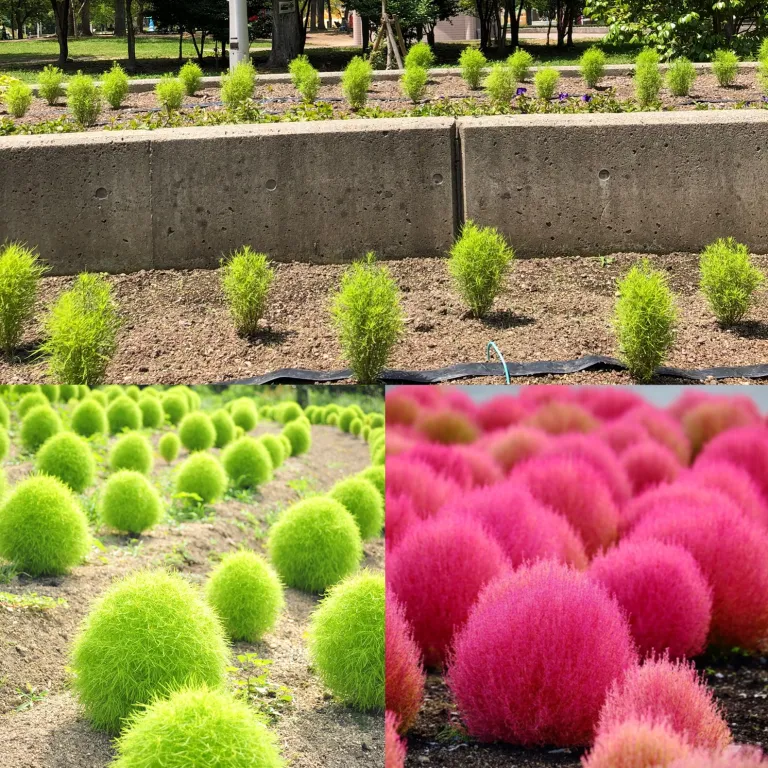
お詫び:最近アダルトサイトが不正にリンクを張り困っています。その駆除対策の最中に突然当サイトがアクセツ不能になりました。何とか修復はできたと思いますが、まだ十分ではありません。しばらく不愉快な思いをおかけするかもわかりませんがご理解ください。もし、アダルトサイトのリンクが張られていても、絶対にクリックしないでください。
Kochia was planted in the nearby park. Although its appearance is still a bit scraggly, from early July it will quickly grow under the summer sun, developing into a cute, round shape of lime green. The spherical bushes reach about 80 cm in height, and their soft texture is also a characteristic feature. As they continue to grow, by the end of summer and beyond the equinox, the green gradually starts to turn red, creating a beautiful gradation of green and red. As autumn deepens, the vibrant red foliage spreads throughout the park, creating a truly breathtaking sight.
Kochia is also known by its Japanese names “Houkigi” or “Houkisou.” As the name suggests, it was traditionally used as material for making brooms. It is believed to have been introduced to Japan during the Heian period and began to be cultivated widely by the Edo period. Besides being used for brooms, it was also utilized as a medicinal herb for general health and to relieve skin itching. Additionally, the mature seeds are used in Akita Prefecture’s local cuisine called “tonburi,” often referred to as “field caviar” or “land caviar” due to its appearance. It is cooked and eaten with grated daikon radish or yam.
Nowadays, there are many famous kochia spots across Japan. The most well-known is Hitachi Seaside Park in Ibaraki Prefecture, where about 30,000 kochia plants are planted on “Miharashi Hill,” which offers a view of the Pacific Ocean. Another notable spot is at Oishi Park on the northern shore of Lake Kawaguchi, where you can enjoy the view of kochia against the backdrop of Mount Fuji.
近くの公園にコキアが植えられました。姿はまだバサバサですが、7月上旬から夏の日差しを浴びてすくすく成長し、ライムグリーンの丸々とした可愛らしい形に成長します。約80cmの球体で、柔らかな感触が心地よいのも特徴です。こうして成長を続け、暑い夏を超した彼岸過ぎには、緑色から少しずつ紅葉し始めて緑と赤のグラデーションの色合いになります。そして秋が深まるにつれて、鮮やかに紅葉した美しい姿が園内に広がるとまさに絶景です。
コキアは和名で「ホウキギ」とか「ホウキソウ」とも呼ばれています。名前のとおり、昔はほうきの材料として使われていました。日本へは平安時代には伝わってきたとされており、江戸時代になるころには各地で栽培されるようになりました。ほうきの材料になるだけでなく、滋養強壮や皮膚のかゆみを止める生薬にも使われたからです。また、成熟果実は秋田県の郷土料理「とんぶり」の材料にもなっていて、その性状から「畑のキャビア」「陸のキャビア」ともいわれ、煮付けて大根おろしやとろろに加えて食べられます。
今では日本の各地にコキアの名所が多数あります。もっとも有名なのは茨城県の「国営ひたち海浜公園」で、園内の太平洋を見張らせる「みはらしの丘」には、約3万株のコキアが植えられています。富士河口湖町の河口湖北岸にある大石公園から見る富士山を背景にしたコキアも見ものです。
